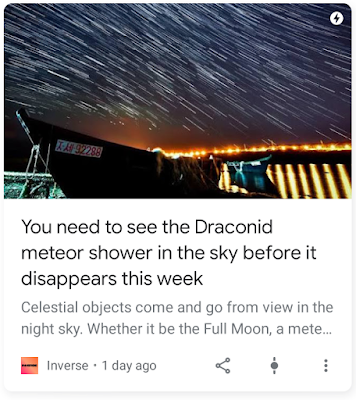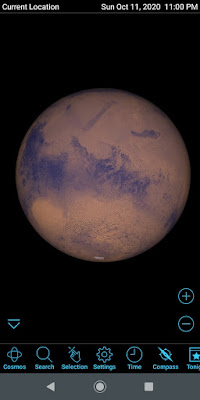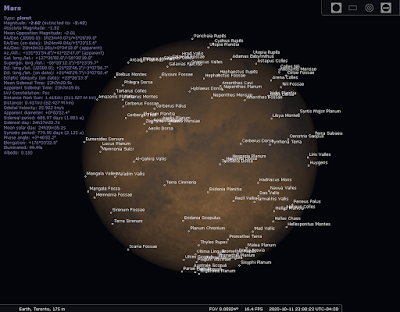It was clear!
But it felt felt humid, damp...
7:33 PM, Fri 16 October 2020. Completed a very fast setup. Quick polar alignment putting Polaris (just at the roof line) at the centre. Did not do a multi-star alignment; simply picked up a planet, and turned on the sidereal (Cel.) tracking. Started with the baader planetarium aspheric 36mm 2-inch.
Did not have a table. Grabbed a bunch of lawn chairs.
Saturn was down in the trees. Jupiter hidden. Ecliptic low.
Saturn was heading to a clear patch...
Instrument: Celestron 8-inch SCT
Mount: Vixen Super Polaris
Method: slewing and tracking with IDEA GoToStar
Rhonda came out. Invited her to have a seat. "Very nice."
Offered to bump the power. Went with the Pentax 20mm XW 1¼-inch. Centred.
7:38 PM. Nice. The shadow on the rings was more pronounced (than earlier this year). Could see the equatorial belt. The Cassini division easily seen on the west; less so on the east. Lots of moons. Seeing was fair.
Rhonda returned. "Oh wow. Can see the stripes." She asked if she was seeing the shadow. You bet.
I wondered how long Jupiter would take to clear the tree.
I took in the whole sky.
7:44. Bright satellite heading due north. Quite bright, actually. Perhaps a minus magnitude?
[ed: Flyover info...
name: CZ-4 R/B
Spacetrack catalog number 29507
COSPAR ID 2006-046-C
Orbit 530 x 600 km, 97.7°
Category unknown
Country/organisation of origin China
Launch date 23 October 2006
Launch site Taiyuan Space Launch Center, China
From Heavens Above.]
We talked about work, the weather, tonight's conditions, the next few days, winter tires, working from home, office access, eyeglasses, turkey dinner.
7:55. Headed to Jupiter. No GRS. Barges. Decent seeing. Missing one moon.
[ed: Io was behind. Would emerge from eclipse around 10:30...]
We talked about satellite distances or elevation. ISS was 400 kilometeres. Low Earth Orbit (LEO). Thickness of the atmosphere. Average height of passenger aircraft. The Right Stuff. Geostationary satellites are at 1000s of km. The next Dragon crew launch. SpaceX's plans for ferrying 100 humans.
8:11. Three moons. Where was the other one? I had the netbook nearby but didn't feel like firing it up.
We talked about colonising Mars. The age we grew up in, including the first humans touching around world; what kids today will experience as we go interplanetary. We went to school without the internet. Paper books. The crazy racket at university. Baby blankets. Another racket. DIY. The missing roll of red film.
Observed Cygnus straight up, Lyra past the meridian, Aquila low, Hercules over the house, little Sagitta.
Another bright satellite went south. Rhonda spotted some others...
Rhonda asked if I was getting cold. Yes. Went for a coat.
8:33. Rhonda thought the view "really nice." She asked what was next... She walked west in the yard. Mars was visible over the hedge... But it would be a while before it was attainable. Unless I moved the 'scope. Didn't wanna do that.
Back to Saturn.
We talking about paintings, nurseries, stars, constellations, planetarium software. Découpage. How to deliver effective Zoom presentations. Messy office backgrounds. Rachel Willis not pulling punches.
Wondered if there was dew on the corrector!?
8:53. We agreed to reconvene in an hour...
Turned off the mount. Headed indoors. Goofed around.
Peaked outside. Mars was good! Mars was clear of the hedge. w00t! Told Rhonda.
10:09. Returned to the backyard. The Red Planet was very good in the telescope. Northern region flat orange, southern hemisphere dark and mottled. A notch. The South Polar Cap (SPC) did not jump out at me.
Neighbour's light was on. Boo.
Eyepiece fogging. Boo.
Rhonda had a look. "Not bad. Crisp edges." Uh huh.
She wondered if Jupiter had set. Nope, but low behind the west trees.
Installed the 8-inch and eyepiece dew heaters, driven by the Kendrick controller, powered by the hacked computer PSU.
Mars was so bright. It looked white on top... Clouds? Haze? Weird. "So amazing," I thought. I felt the view was incredible. North was up.
The seeing looked fair. "Let's give it a shot." I installed the Tele Vue Type 6 Nagler 9mm.
10:27. Got it! Saw the SPC. Tiny!
Rhonda saw the lightness at the top, at the 12:30 or 1:00 position. Yep. North polar hood, likely clouds.
I asked what she thought. She seemed nonplussed. Mind you, she had watched our live video from the 74-inch so the bar had been raised pretty high. And the processed pictures that had been shared were pretty impressive.
We talked about how big Mars could appear. Oppositions versus superior conjunctions, equipment, aperture, resolution. I wondered if I had every seen Mars in my 'scope so big. The 2003 event at York... I reflected back on that. But I had been a little preoccupied. And back then? What eyepieces did I have?! Now I had the 9mm.
10:41. I did not think I was feeling any heat off my new custom DIY dew heater. Was there a problem? Had it failed?!
10:42. Checked the Sony voice recorder. Only 2½ hours left. Battery level: middle. I considered VOX. Then I shut off continuous recording.
Mars: North Polar Hood (NPH) was quite large. SPC visibile. Dark band through the equator. Looked like Mare Cimmerium... [ed: Yes! To the east. Mare Sirenum to the west.] There was a split. Another dark region to the south. Tremendous size at 222 times magnification. Tried to detect features in the north...
Rhonda retired.
Installed the occulting ocular, the Meade (4000) 32mm Super Wide Angle (SWA) (from Tony dos Santos). Recently painted. That is, the field stop occulting sheet (aluminium duct tape) I had recently paint flat black (with Rhonda's help). [ed: I believe this is a Plössl-type eyepiece with a 67 degree AFOV. Long eye relief.]
11:04. Started field identification of stars...
11:09. A batch of clouds came through. Scuppered for the moment. Checked the Oregon Scientific Instruments portable weather station: 76% relative humidity, pressure dropping, rain tomorrow, 1.0°C air temperature, new Moon phase, October 16, battery level OK.
Clouds got worse.
Headed inside again!
Toes were cold.
11:14. Back inside. Clouded out. Checked the AWC site. Just at the edge of skirting clouds.
Put on my Baffin Island -100°C boots!
12:01 AM, Saturday 17 October 2020. Popped outside. 100% low cloud! Boo! It was eerily bright, the local light pollution reflection off the low layer.
Killed time.
Peeked out the window. Dark. Stars! OK. Back on the horse.
12:29 AM. Pleiades was up. Mars was really high. No clouds. Good for a while. Also keen to get Cetus targets... Meade was still installed. I wanted to get some moons.
Noted a ring or halo again! Seen before... I had seen this with Vega (back in June). Around Mars. Bright objects. It went out just beyond the nearest star [ed: TYC 00026-0648 1]. I wondered what the diameter was... [ed: It is around 12 arc-minutes.]
Needed more grunt. Installed the Tele Vue PowerMate doubler. The Beast!
12:46. Got the star TYC 00026-0162 1, north of Mars. Magnitude 11.5. Deimos was mag 11.8. The star would not take direct vision. Oh boy...
12:52. Spotted to the north and east Pisces stars that were magnitude 11.5 and 11.7. With the Tele Vue PowerMate 2 and Meade 32.
Should have been possible!
Ugh. Not seeing anything.
Put the 9mm in.
12:58. Never done before. 2x with the 9mm. So, that's 444 power, right?
Gave up. Could not see moons near to Mars. I was disappointed...
OK. Switched to double star mode. I had a couple of targets in Cetus I wanted to check off. Chose my first.
The body of the sea monster, quadrangle of faint stars, was to the south.
While star hopping from ε (epsilon), I spotted the target in the finder scope (Orion 9x50). A relief as I thought for a while I was going the wrong way. From a semi-urban location. In other words, should be visible in binoculars.
Arrived HD 9336 in Cetus.
1:14. Yellow and blue stars. Very wide in the 36mm. To the east was a big isosceles triangle. Bright star at the edge of the field, to the north-east [ed: HD 9421, a triple!]. Mostly empty field. Faint stars. Up was north-west for me. The pair was oriented (somewhat) east-west. Same brightness? I think? That was the first impression. Yellow to the west; blue to the east. Not Earth shattering. Doable.
I had a really hard time focusing. Poor seeing. The trees breathing? In and out.
Below the triangle, on the west side of the double, there was a line of stars, in a slight arc.
It occurred to me that I did not have the "compensating" magnifier/reducer factor in the SkyTools on the John Repeat Dance computer.... for visual. To re-scale the view, given the focuser. 1.1? Need to add.
Maybe the A (west) star was a touch brighter? Just a hair. [ed: SkyTools says 6.8 and 7.4.]
Seeing went bad. In and out.
Next: HD 2394 aka HJ 1968.
Starhopped from β (beta). Used the field stars using a faint little triangle.
1:27. Didn't see it at first. Primary is obvious; the companion is much fainter. Unequal pair. White and orange, maybe?. Oriented north-east to south-west. Widely separated with the 36mm. But the B star was just borderline visible. SkyTools said B was 9.8. Different by over 2½ magnitudes.
Noted an inline star, SAO 147293, to the north-east.
A line of stars to the south going east-west.
1:32. Could not spot the C star.
AB: Yellow and orange.
I was angled low. I was aimed into light polluted skies from Toronto and Mississauga.
Not a great pair...
The RA motor cover was starting to press on the mount. Did a meridian flip.
One more in Cetus. HD 3125. [ed: The Washington Double Star database designation is D 2.]
Started at ι (iota). Frustrating star hop but worth it. There were a couple of bright stars, a decent star hop, but I got all turned around...
2:00. Oh. I like it! White and orange. Very close. Attractively close! The main pair was oriented south-west to north-east. About a magnitude or two different.
[A and B are too tight.]
Outlier. The D star was to the south-south-east. 10 times the distance.
Spotted another star, kind of opposite. North-west. Not related. [ed: ST3P says TYC 04675-0149 1.] 1.5x times the AD distance.
Another star to the north. 2x the AD separation. So a big triad.
Nice. OK. Good. Mission accomplished. Nice to close that chapter...
Returned to Mars.
2:12. 9mm. Now south was up. SPC was easy. The notch was pretty well at the Central Meridian (CM). [ed: The gab between Mare Cimmerium and Mare Tyrrhenum.] Seeing was really good. So big. Lovely colours, pale orange, very uniform in the north. Tried to spot features, like Cerebus. Between the highlands at the equator and to the south, it was somewhat mottled black and grey.
Was Syrtis Major rounding the bend?
Three days after opposition. Wow. Really nice.
Similar view as the DDO night...
Didn't seem like the dew heaters were not working. I had switched to my custom controller with an active duty cycle on both. And I tried the cup warmer on the eyepiece. So now I was sure it wasn't a problem with my new hand-made unit. I wondered if the computer power supply was not putting out enough amps. I thought I had used it before... Maybe I should always use a SLA battery.
Should I keep observing, I wondered? Will there be other opportunities? Is this as good as it gets? Should I sketch?
Tired...
That's it.
2:18. Humidity 82%, 1.1°C, pressure steady, rain tomorrow.
Did a very rapid tear down, intending to sort in the morning...
Grass was wet.
2:37. Back inside. Finished hauling gear from airlock.
I enjoyed that. Great views of Mars! I enjoyed soaking in the view. The Martian moons still elude my eyes though. That the dew heaters weren't working is odd but it must be the source. Tracking was pretty amazing for the night. That was especially amazing given I did not to a star alignment and I had put Polaris in the centre.
§
Learned the reason the custom eyepiece heater wasn't putting out power. Two faults actually. The "rail" copper power lead had not been soldered and unwound itself, through flexure. I don't know why I didn't solder it. Easy fix. More seriously, the leg of the nichrome wire broke, near the mechanical fastener. Damn. Knew that was going to happen, with too much flexing. It needs to be stabilised...
After bench testing, found the 8-inch outputting heat. Yeh. It's a trooper!




























